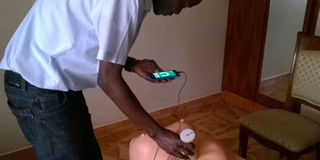How a mobile app aims to reduce child and maternal deaths

Joshua Okello demonstrates how the pinard horn that is connected to a mobile phone can be used to monitor the heartbeat of the child in the womb. Photo by Patience Ahimbisibwe
What you need to know:
Reducing maternal and child deaths remains a big challenge in Uganda. However, two young software developers are aiming to address this challenge through an innovative app that they have developed.
The trauma of carrying a dead foetus in the womb for four days is still fresh in Susan Arinda’s memory. Two days before this fateful incident, she had visited her midwife who informed her that all was well. But upon returning home, she felt uncomfortable and a friend advised her to return to the health facility. There, the foetal heartbeat was monitored using a pinard horn fetoscope.
Even though it had been just a few hours earlier when Arinda underwent the same procedure, the expression on the midwife’s face could tell something was wrong.
“It was too late to save my unborn child. I spent three days without feeling the baby’s kicks yet at the antenatal check-up this was not detected,” says Arinda.
She adds: “I was frustrated yet the baby had to be removed. By this time, my blood pressure had gone up. It had to be controlled before I could be induced. An operation could not be undertaken to avoid cases of infection,” she recalls.
It is stories such as Arinda’s that has inspired two Ugandan software developers, Joshua Okello and Aaron Tushabe, to devise ways of improving the health of children and mothers by being able to monitor things such as heartbeat or cases of risky pregnancies and deal with them early enough.
But they are not using new technology. Instead they are improving the pinard horn, an old system listening device for foetal heartbeat by connecting it to a smart phone, which will then relay the information.
The WinSenga innovation
The innovation called the WinSenga, is a software application used on a windows phone that enhances and extends the functionality of a pinard horn to deliver timely, effective, quality and affordable antenatal diagnosis and care.
It uses a smartphone based ultra sound alternative that feeds into a community based diagnosis and referral system. The phone has a global positioning system (GPS) and a microphone to connect the two devices.
During diagnosis, the pinard foetal stethoscope is put on the expectant mother’s womb, which then transmits the sound to the smartphone.
After obtaining all the required information, the health worker sends the summary to the expectant woman on the phone.
How it works
A pinard horn is a wooden or metallic device used by midwives and doctors to listen to the heart rate of a foetus in the womb. The midwife first searches for the baby’s heart and then uses the pinard horn to listen to its heartbeat.
Okello says the improved version of the pinard relays instant information about the status of the unborn child, and this helps the health provider to offer any medical assistance depending on the need.
“A midwife has to listen but also calculate the number of heartbeats. This may end up with some errors,” he says of the current pinard horn.
With the improved version, Okello says the results are more likely to be accurate if done correctly.
At Joy Maternity Centre in Nansana, Wakiso District, Joyce Zalwango, a midwife, has had the technology experimented at her facility.
“WinSenga is better because the foetal changes are detected on phone and not the ears. Sometimes the mother might have suffered intra uterine foetal death, but a midwife using the pinard horn might mistake the maternal pulse for the foetal heart,” Zalwango says.
With a promising innovation at hand, the developers of the app are currently looking for Shs100m funding to do clinical trials.
“Before we go on the market, we need to complete designing the hardware and do clinical trials,” he says.
However, Okello is frustrated that despite the country having a big challenge of trying to reduce child and maternal deaths, government has not picked interest in this innovation, which he says could be the game changer in the campaign to end maternal and child deaths in the country.
Cheap alternative
He says the pinard horn, which costs Shs20,000 is cheap and available in most health centres compared to a fatal doppler, which costs Shs17m.
He says many pregnant women, especially in rural areas travel long distances to access the nearest health facility. “We have decided to use readily available low cost technology to deliver equivalent quality care during the time of birth especially, in rural areas. We got the pinard horn which many people are familiar with and decided to link it to another equally known technology—the mobile phone,” explains Okello.
He adds: “It is important to monitor the baby before birth and after. During pregnancy, the foetus can be distressed or the cord can get wrapped around the neck. If the unborn child is not monitored and taken care of, the chances of having a still birth are high.”
State minister for Primary Health Care, Sarah Opendi acknowledges that maternal and child health issues remain a big development challenge that government is committed to addressing.




